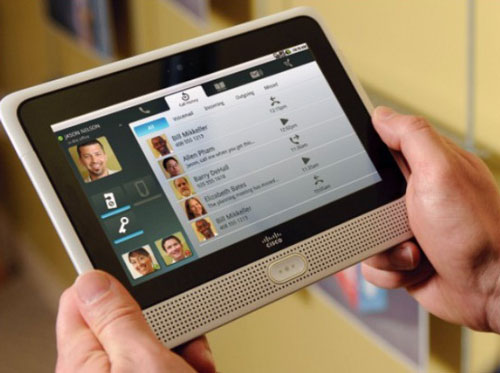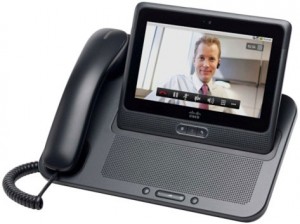
With all its rivals focusing their tablet computing offerings squarely at consumers, networking giant Cisco is taking a bet that its tablet offering, the Cius, will appeal to the corporate set. The product, which is now on sale in SA, is only available to business customers.
The seven-inch Android-based tablet has a 1,6GHz Intel Atom processor, a back-lit, multi-touch LCD screen with a resolution of 1024×600 pixels, 32GB of storage, front and rear cameras both capable of 720p video (and offering support for all Cisco TelePresence videoconferencing) and weighs just 535g.
At launch, there is only a Wi-Fi model available, but mobile broadband models will follow soon. The Cius includes a microSD slot for expanding the on-board memory. This can also be secured so the card can’t be read when used in a device other than the Cius.
Despite its capable hardware, the Cius runs the somewhat outdated Android 2.2. The company says this is because of the need for high security specifications and that there will be support for Android 3.1 in future.
Regarding the decision to go for a 7-inch screen, Cisco engineer Leon Wright says the company decided seven inches was the ideal combination of functionality and portability.

Considering its target market, it’s not surprising the Cius offers virtual desktop integration, a unified communications porfolio, cloud centralisation of device management, and high-definition videoconferencing support, all of which is complemented by its “contacts-driven” user interface. The Cius also ships with QuickOffice preinstalled for viewing and editing all major document formats.
It offers operating system and file system-level encryption, password management, the ability to push and enforce policies remotely, the large-scale provision of services across multiple devices and the ability to remote lock or wipe the device – or a batch of them – on demand.
The Cius connects to a company’s existing telecommunications network via an optional docking station, which supports fixed-line telephony, includes a full duplex speaker for hands-free use, two USB ports for a keyboard and mouse, an HDMI-out port for extending video capabilities to an external display, and a power-over-Ethernet port for networking and charging.
Another feature of the Cius that has yet to make its way to consumer tablets is the detachable battery that offers an anticipated eight-hour battery life and can be swapped out with a spare if necessary.
Cisco has also created an application store that it calls App HQ, which is complementary to the Android Market. Apps HQ hosts applications specifically designed for the Cius and tested by Cisco.
It is also possible for system administrators to limit which apps users can install, and can do this per user or per group of users – for example, the sales team can all be granted access to the same apps.
System administrators can even create a custom marketplace with handpicked apps for their particular business.
The Cius costs US$750, but Cisco says this price can be driven down to around $650 in the case of bulk orders (rand pricing is not available). That’s a hefty price tag, particularly considering the dock and any additional equipment, like the carrycase, send the price even higher.
Despite the high price, Cisco should enjoy some demand for the Cius from those who do a great deal of teleconferencing. — Craig Wilson, TechCentral
- Subscribe to our free daily newsletter
- Follow us on Twitter or on Facebook
- Visit our sister website, SportsCentral (still in beta)

